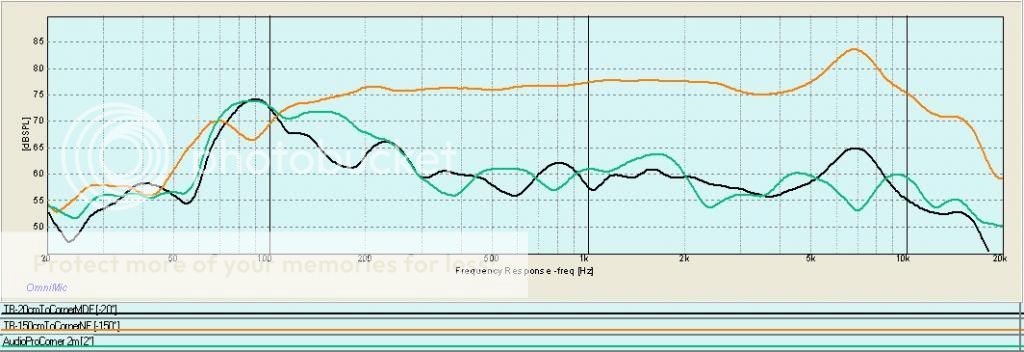Frequency Responces (Dayton Omnimic near field)
At the first set of curves I had forgotten the tone controlls at full tilt, this was rectified for the second set. The calculated value was 800 µF but I measured the whole range. 0-2200µF
Notable features
Pivot point is at the resonance frequency no cap is black top trace.
Brown bottom trace is 200µF that reduce the 50-80 Hz hump a lot but also introduce a peak at 40 Hz very much as first order crossovers does (not) work with most dome tweeters.
The red trace for 400µF looks much better.
The jumps at 70 and 95 Hz is as of now unexplained.
I the next set (with tone controls set at defeat) I focused on what appears to be the most resonablce capacitance range 400-900µF in 100µF increments for clarity some of them is not included in the graph.
With the current setting 400-600 µF seems to be best, but with the crossover in place the Q will go up a bit so any final tweeking with regard to the size of the serial cap has to wait.
But these findings suggest that you can tame high Q drivers with serial caps. The peak caused by the to small cap could be explored in an open baffle speaker where the peak is set to compensate for the baffle drop off and then the rapid fall below that would protect the driver.
Time to tackle the crossover and the tweeter...
At the first set of curves I had forgotten the tone controlls at full tilt, this was rectified for the second set. The calculated value was 800 µF but I measured the whole range. 0-2200µF
Notable features
Pivot point is at the resonance frequency no cap is black top trace.
Brown bottom trace is 200µF that reduce the 50-80 Hz hump a lot but also introduce a peak at 40 Hz very much as first order crossovers does (not) work with most dome tweeters.
The red trace for 400µF looks much better.
The jumps at 70 and 95 Hz is as of now unexplained.
I the next set (with tone controls set at defeat) I focused on what appears to be the most resonablce capacitance range 400-900µF in 100µF increments for clarity some of them is not included in the graph.
With the current setting 400-600 µF seems to be best, but with the crossover in place the Q will go up a bit so any final tweeking with regard to the size of the serial cap has to wait.
But these findings suggest that you can tame high Q drivers with serial caps. The peak caused by the to small cap could be explored in an open baffle speaker where the peak is set to compensate for the baffle drop off and then the rapid fall below that would protect the driver.
Time to tackle the crossover and the tweeter...
















